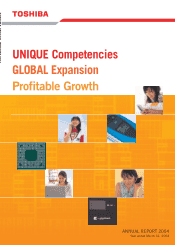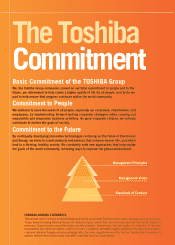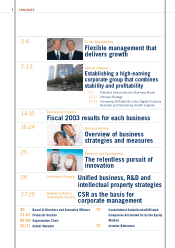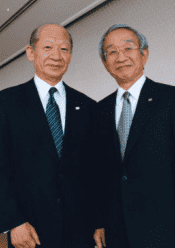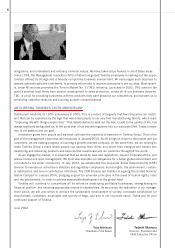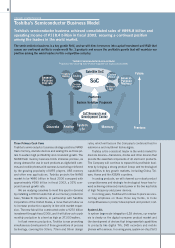Toshiba 2004 Annual Report Download - page 10
Download and view the complete annual report
Please find page 10 of the 2004 Toshiba annual report below. You can navigate through the pages in the report by either clicking on the pages listed below, or by using the keyword search tool below to find specific information within the annual report.
8
Toshiba’s Semiconductor Business Model
Toshiba’s Semiconductor Business Model
Proposals with existing businesses/Integration of support businesses
Three Primary Cash Cows
Toshiba’s semiconductor business strategy positions NAND
flash memory, discrete devices and analog ICs as three pil-
lars to sustain high profitability and consistent growth. The
NAND flash memory business holds immense promise, as
strong demand for use in such products as digital still cam-
eras and mobile phones with cameras is now being reinforced
by the growing popularity of MP3 players, USB memory
and other new applications. Toshiba projects the NAND
market to be ¥880 billion in fiscal 2006 compared with
approximately ¥380 billion in fiscal 2003, a 32% com-
pound annual growth rate.
We are readying ourselves to meet this spurt in demand
by installing a 300mm wafer fab at our memory production
base, Yokkaichi Operations, in partnership with SanDisk
Corporation of the United States, a move that will allow us
to increase production capacity in line with market expan-
sion. The new fab will be constructed under a ¥270 billion
investment through fiscal 2006, and it will allow us to push
monthly production to a level as high as 37,500 wafers.
In flash memory production, Toshiba is now promoting
simultaneous development of three generations of process
technology, covering the 90nm, 70nm and 55nm design
rules, which will secure the Company’s continued lead in
submicron and multilevel technologies.
Toshiba is the consistent leader in the world market for
discrete devices—transistors, diodes and other devices that
provide the essential components of all electronic products.
The Company will continue to expand this profitable busi-
ness by bringing a strong product lineup and technological
capabilities to key growth markets, including China, Tai-
wan, Korea and the ASEAN countries.
In analog products, we will channel our robust product
competitiveness and strategic technological know-how to-
ward achieving enhanced market power in the two key fields
of high frequency and power devices.
In coming years, Toshiba will continue to place an unre-
lenting emphasis on these three key fields, to hone
competitiveness in product development and product cost.
System LSIs
In system large-scale integration (LSI) devices, our empha-
sis is clearly on the digital consumer product market and
the development of devices that bring essential capabilities
to products like digital TVs, DVD recorders and mobile
phones with cameras. In coming years, system-on-chip (SoC)
UNIQUE COMPETENCIES
Toshiba’s semiconductor business achieved consolidated sales of ¥898.8 billion and
operating income of ¥118.4 billion in fiscal 2003, securing a continued position
among the leaders in the world market.
The semiconductor business is a key growth field, and we will direct resources into capital investment and R&D that
assure our continued ability to create world No. 1 products and secure the profitable growth that will maintain our
position among the world leaders in this competitive industry.
General-
Purpose
Memory
Memory
System
LSI
Analog
Discrete
Peripheral
Logic
Custom
Memory
Custom
Discrete
Analog
Peripheral
Analog
General-
Purpose
Discrete
SoC
R
esea
r
c
h
a
n
d
D
evelo
p
ment Center
S
o
C
System Solution Proposals
Platforms
Sate
ll
ite
SoC
Future
Previous

